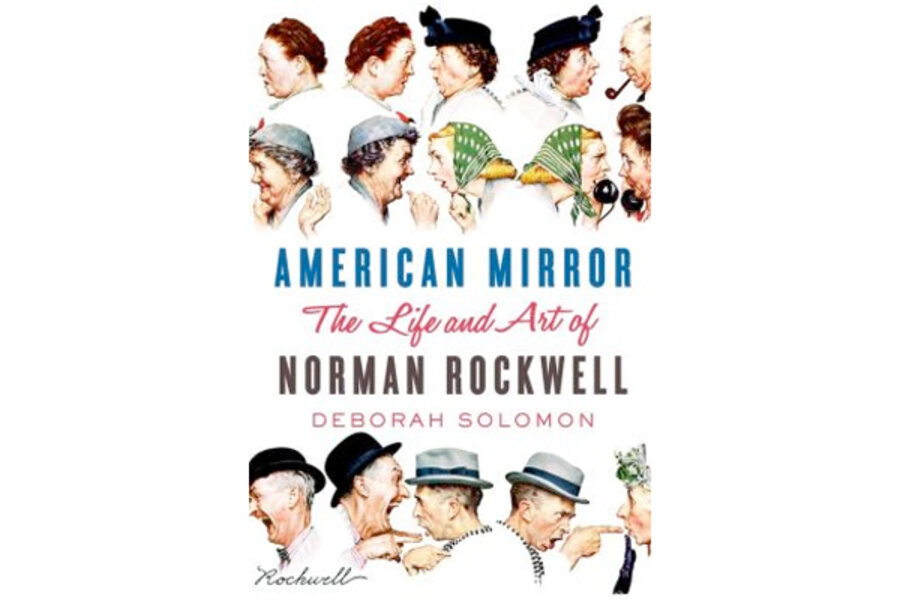American Mirror
Loading...
Deborah Solomon tells a revealing anecdote midway through American Mirror, her new biography of Norman Rockwell. One of the painter's three sons was home sick in bed and asked his father to draw him some clowns. Rockwell, by then renowned for his all-American Saturday Evening Post covers as well as for his patriotic World War II-era posters of the Four Freedoms and Rosie the Riveter, demurred, insisting he was unable to draw without a model or photograph to use for reference. This sad little episode captures both the paralysis Rockwell often experienced around painting and the difficulty he had connecting with his family. Both of these themes run through Solomon's sharply perceptive book, which shows Rockwell to be a lonely, anxious man whose life bore little resemblance to the idealized scenes depicted in his work.
Art critic Solomon has written biographies of Jackson Pollock and Joseph Cornell, but she's perhaps better known for her occasionally biting "Questions For" column, which ran in The New York Times Magazine from 2003 to 2011. Her easy command of 20th-century American art and her prickly intelligence combine well here: "American Mirror" is an engaging and enjoyable read, and Solomon manages to be both authoritative and breezily conspiratorial in tone ("the twenties sometimes seem too silly for words," she declares at one point).
Rockwell, who was born in 1894 and grew up in New York City, was a poor student as a boy but demonstrated a precocious talent for drawing. His early ambition was to be a famous magazine illustrator, and he succeeded wildly, producing, over nearly half a century, 323 covers for The Saturday Evening Post, which Solomon calls "the national frame of reference" before radio, television, and then the Internet assumed that role. His masterfully detailed covers tended to tell folksy stories about small-town life: a boy on a train struggles to keep his squirmy dog hidden in a picnic basket; a kindly doctor examines a little girl's doll with a stethoscope. Rockwell, though, was a victim of bad timing, embarking on his career just as the legendary 1913 Armory Show brought modernism to America. "He had the misfortune to come of age at a time when realist painting was written off as less 'authentic' than abstract painting," Solomon observes. For years his reputation as a sentimental square endured, even when, late in his career, he began to embrace progressive causes, turning to school desegregation and violence against civil rights workers for subject matter.
Rockwell in turn maintained a defensive distance from the art world, insisting that he was an illustrator, not an artist. His friends wondered why, once he'd achieved fame and financial security, he continued to churn out work for the Post and the Boy Scouts (for whose annual calendar he completed one piece a year), leaving no time to paint for himself. But according to Solomon, he was only able to work when "fulfilling an obligation." His paintings were rarely exhibited during his lifetime, and when they were occasionally sold, they went for "prices that today seem indecently low." (Unfortunately, the book ends with Rockwell's 1978 death and doesn't explore the rehabilitation that his reputation has undergone since.)
Solomon suggests another reason Rockwell kept his schedule filled with deadlines: so he could escape to his studio daily and avoid his family. A needy man who required someone to take care of him yet remained emotionally unavailable, Rockwell married three times. His first marriage ended in divorce, with his wife Irene charging that Rockwell "had barely looked at her" in their 14 years together. His second marriage resulted in the birth of his three sons, who only learned of their father's first wife when they read a profile of him in The New Yorker. Solomon characterizes Rockwell as "an ineffectual and distracted father," and his second wife, Mary, descended into alcoholism and depression before dying at 51. By then, after having lived in New Rochelle, N.Y., and Arlington, Vt., the family had settled in Stockbridge, Massachusetts, so that Norman and Mary could be treated at the Austen Riggs psychiatric hospital. (Rockwell saw famed psychoanalyst Erik Erikson for seven years.) In Stockbridge he met his third wife, Molly, and their marriage was perhaps his most successful. They were in their sixties and slept in separate bedrooms.
Rockwell's apparent lack of interest in his wives and his tendency to attach himself to a series of adoring, younger male friends leads Solomon to consider whether he was gay. (She also finds something "problematic" about his constant trawling for young boys to model for him – boys so far outnumbered girls in his work that an early profile, in The Boston Globe, had the headline "Draws Boys and Not Girls" – but says there is no evidence of inappropriate behavior.) Solomon concludes that the repressed and compulsive artist who spent as much time in his studio cleaning as he did painting, used his marriages to try to control "his homoerotic desires." At the start of "American Mirror," Solomon writes, "I would argue that angst is probably over-represented in modern art. Surely we can make room for an artist who was more interested in running toward the light." By book's end, once we've learned how much personal angst Rockwell lived with, the phrase "running toward the light" seems especially, and poignantly, apt.
Barbara Spindel has covered books for Time Out New York, Newsweek.com, Details, and Spin. She holds a PhD in American Studies.






